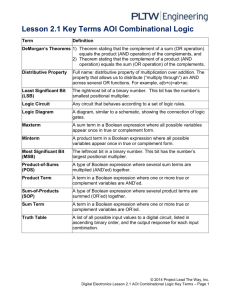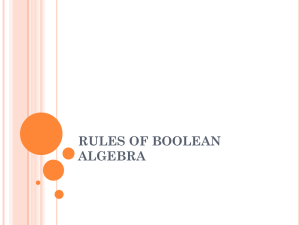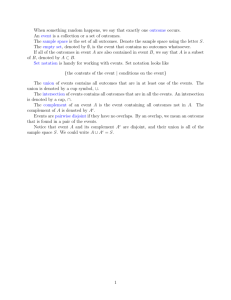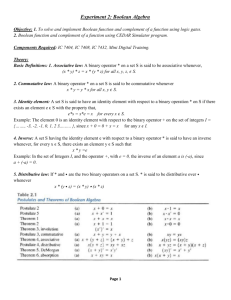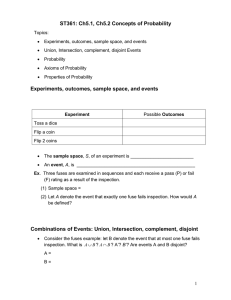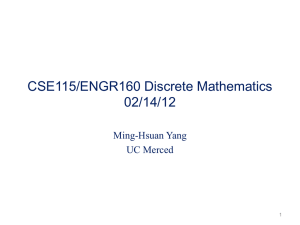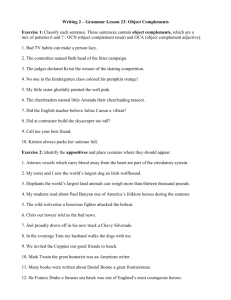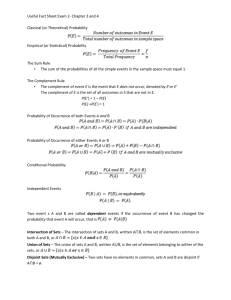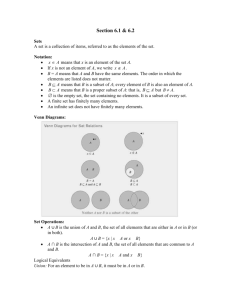Set Operations: Relative Complement
advertisement
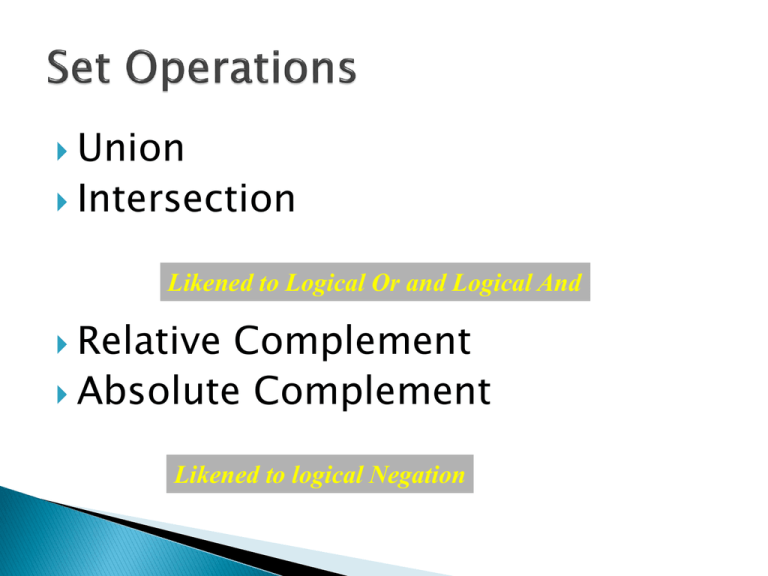
Union
Intersection
Likened to Logical Or and Logical And
Relative
Complement
Absolute Complement
Likened to logical Negation
The union of two sets is the set that
contains elements belonging to either of
the two sets
Equivalent to the Boolean operation “or”
Written as:
Examples:
A = {a, b, c, d}
B = {c, d, e, f}
A B = {a, b, c, d, e, f}
Note that the set could have been described as
{a, b, c, d, c, d, e, f}
A = {a, b, c, d}
B = {c, d, e, f}
Sets overlap
A B = {a, b, c, d, e, f}
A = {a, b, c, d}
B = {x, y, z}
Sets are
A B = {a, b, c, d, disjoint
x, y, z}
The intersection of two sets is the set of all
elements common to both sets
The intersection of disjoint sets is the
empty set
Equivalent to the Boolean operation “and”
written as:
Examples:
A = {a, b, c, d}
B = {a, b}
A B = {a, b}
A = {a, b, c, d}
B = {x, y, z}
AB=
A = {a, b, c, d}
B = {a, b}
A B = {a, b}
A = {a, b, c, d}
B = {x, y, z}
AB=
The relative complement (difference) of
two sets is the set of elements contained
in one, but not both, of the sets
Related to the Boolean “Exclusive Or”
Written as: —
Examples:
Given: A = {a, b, c, d} and B = {a, c, f, g}
A — B = {b, d}
B — A = {f, g}
A = {a, b, c, d}
B = {a, c, f, g }
A — B = {b, d}
B — A = {f, g}
The absolute complement of a set is the set
of elements which do not belong to the set
being complemented’
Equivalent to the Boolean operation “not”
Written as a superscripted ‘c’
Example:
U = {a, b, c, d, e, u, v, w, x, y, z}
A = {a, b, c, x, y, z} and B = {a, b, c, d, e}
Ac = {d, e, u, v, w} Bc = {u, v, w, x, y, z}
U = {a, b, c, d, e, u, v, w, x, y, z}
A = {a, b, c, x, y, z}
B = {d, e, y, z}
Ac = {d, e, u, v, w}
Illustrates the 8 possible relations between Sets, A, B and C
Region Relationship
A B C
1
3
A B
A B
4
A
5
A
A
A
2
6
7
8
C
C
B C
B C
B C
B C
A B C
Shows whether an arbitrary element x belongs in any of the indicated sets.
Sets
A
N
N
Y
Y
B
N
Y
N
Y
Operations
A B
A B
N
N
Y
N
Y
N
Y
Y
Idempotent Laws
AA=A
AA=A
Associative Laws
(A B) C = A (B C)
(A B) C = A (B C)
Commutative Laws
AB=BA
AB=BA
Distributive Laws
A (B C) = (A B) (A C)
A (B C) = (A B) (A C)
Identity Laws
A=A
AU=U
AU=A
A =
Complement Laws
A Ac = U
A Ac =
De Morgan’s Laws
(A B)c = Ac Bc
(A B)c = Ac Bc
Uc =
c=U
